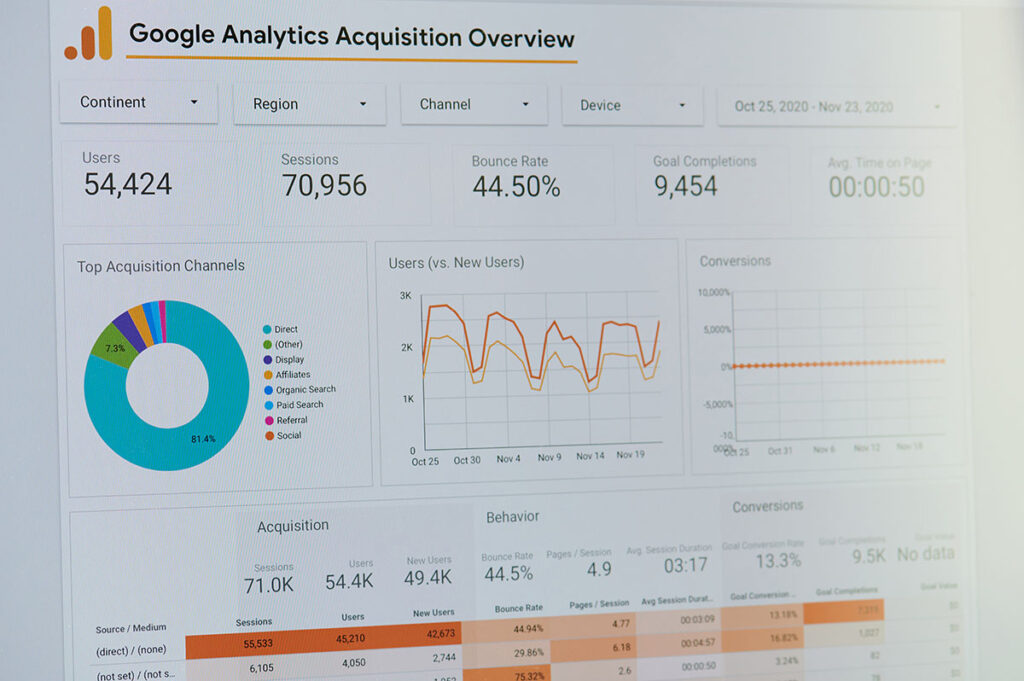
New York, USA – November 24, 2020: Google analytic acquisition overview on laptop screen
In the ever-evolving world of digital marketing and web analytics, change is inevitable. But when Google announced its decision to permanently delete all Universal Analytics (UA) data in July 2024, it sent shockwaves through the online business community. While Google Analytics 4 (GA4) offers new and exciting features, it’s essential to consider three significant reasons why this move is bad for businesses.
Reasons to Download and Save Your UA Data
1. Historical Insights Vanish
Over the years, businesses have collected a treasure trove of data through Universal Analytics. This historical data has been invaluable in understanding user behavior, tracking trends, and making informed decisions. By deleting this historical data, businesses lose the ability to analyze past performance, hindering their capacity to analyze options and make strategic decisions.
2. Data Continuity is Disrupted
The transition from UA to GA4 isn’t always seamless. Many businesses have ongoing projects, reports, and custom integrations built around their UA data. Deleting UA data before GA4 has matured could lead to disruptions, delays, and additional costs in adapting to the new analytics ecosystem.
3. Loss of Benchmarking Opportunities
Universal Analytics allowed businesses to benchmark their performance against industry standards. The deletion of UA data eliminates the opportunity to compare your performance to others in your niche, making it harder to identify areas for improvement and competitive advantages.
Despite these challenges, there is a silver lining in the GA4 transition. Merging UA and GA4 data offers several compelling benefits, which can outweigh the drawbacks. Details follow…
Benefits of Merging UA & GA4 Data
1. Comprehensive Data Integration
Merging UA and GA4 data allows businesses to create a holistic view of their web analytics. You can track user interactions across platforms, providing a more complete understanding of your customer’s journey.
2. Enhanced User-Centric Insights
GA4 focuses on user-centric analytics, allowing businesses to better understand their audience’s behavior and preferences. With this insight, you can tailor your marketing efforts more effectively, resulting in higher conversion rates and customer satisfaction.
3. Advanced Data Visualization
Integrating UA and GA4 data enables the creation of unique data visualizations. Custom dashboards and reports can provide a seamless and intuitive way to analyze your web analytics data, making it easier to extract actionable insights.
Unlock Robust Analytics Insights Enabling Better Decisions
In conclusion, the impending deletion of Universal Analytics data by Google is undoubtedly a challenging transition for businesses. However, by embracing the opportunities presented by merging UA and GA4 data, companies can unlock more robust insights, ultimately driving better-informed decisions and improved performance. The key is to plan ahead, make the most of the available tools, and leverage the power of data to thrive in the evolving online marketplace.
Avid Demand has been shepherding businesses large and small through the challenging transition to GA4. With this new announcement of historic data being deleted, we’ve built a proprietary solution to merge your UA and GA4 data into a single data visualization tool. Reach out if you’d like to talk more about what we can do for you!
Don’t Miss a Beat!
Receive current information, expert advice, helpful tips, and more…
* Your privacy is important to us.
